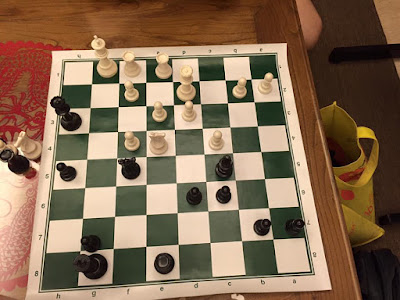Improved Training Method
How I added to and improved the method
The 2012 method, I am just passively learning. I am not
pushing myself when I play through a game. The most I push myself is when I replay
the game without looking at the book. What I have been doing for the past week
are solving the puzzles in the Grandmaster Preparation series: Attack and
Defense, endgame, Positional play, Calculation and Strategic. What I like about
the puzzles is not that they are taken from real 2600-2700 GM games (which is
awesome), but that a lot of the positions are not play and win in the sense
that you win a piece. They are more like play and get a better position/good
winning chances. Some puzzles are just like choose the best continuation. And
all this mirrors a real game. What I do with my friend is we set up each new
puzzle on a board and we think, actually really think and we sit opposite each
other as though were playing a tournament game. This is to simulate tournament
conditions. I really recommend these books. My initial plan was to go through 1
puzzle from each book a day, 4 books (we are not using Strategic yet), 4
puzzles. But we go through the limit a few times. So be flexible, you may not
have 2-3 hours every day so adjust the number based on how much time you are
willing to invest. It could be 1 hour, it could be 1 puzzle. Now, time for some
chess. Since I will be going through at least 28 puzzles a week, there will be
some good puzzles I come across which are instructive. I will give some
annotations as to what I was thinking, explain my thought process in solving
them.
This puzzle is from Attack and Defense GM Prep Book chap 1
puzzle 1. My friend and I looked at the puzzle, then we close the book and then
we set it up. This is good practice for you guys as well.
Black to move and win. Theme is Include all pieces in the
attack.
Try solving it for yourself first.
Below is my thought
process.
When I first saw the position, I saw that white is
threatening e6 (what is white threatening?). I also saw that g2 is very weak.
So I immediately started looking at how to put pressure on g2. 1…..Rxg2 came to
mind first, I also saw 1….Qg6 2. Qxd8+ Kh7 3. Rf2 Rxf2 4.Kxf2 Qc2+ 5. Ke1 and I
didn’t see anything else. Then I calculated 1….Rxg2+ 2.Kxg2 Qg6+ Kf2 3. Qf5+
but without the Rook, Black’s queen isn’t that strong. I calculated 1….Bh3 but
simply 2. Rxd8 just loses for black. The problem with all these lines is that
the Bishop on d7 is pinned to the d8 Rook.
Then I thought ok,
Black’s rook should get out of the pin to free the black bishop, I looked at 1….Rb8
attacking the queen, but White has 2. Qd4. Then, I saw 1…..Rc8 simply
threatening Rcc2 and moving out of the pin. If 2. Rc1 then u exchange on c1 and
play Qg6 with Bh3 and Qc2 coming, Black has a strong attack.
What you should take away from this puzzle is to always look
for targets. Here it is obvious the g2 pawn is weak since ALL black’s pieces
can attack it. There is this book I think everyone should read: What it takes
to be a chess master by Andrew Soltis. In chapter one, it talks about knowing
what matters most in the position. One of the other chapter talks about targets
(find the weakest point) and that targets=initiative.



Comments
Post a Comment